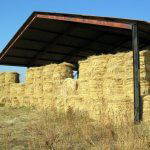 Horses and ponies’ digestive systems are designed to constantly take in food; preventing this natural feeding behaviour can lead to gastric ulcers and stereotypic behaviours as a stress coping mechanism. Consequently, feeding a good quality forage is a vital part of horse husbandry.
Horses and ponies’ digestive systems are designed to constantly take in food; preventing this natural feeding behaviour can lead to gastric ulcers and stereotypic behaviours as a stress coping mechanism. Consequently, feeding a good quality forage is a vital part of horse husbandry.
How hay is stored can have a big impact on its nutritional value, quality and how long it lasts. During storage dry matter losses result from plant respiration, microbial activity and weather deterioration. There are always some losses from respiration (the continuation of normal plant processes) but this is essentially unavoidable. Microbial activity associated with heating uses soluble carbohydrates, which reduces digestibility and increases fibre levels.
How should I keep my hay?
Keeping hay protected from the elements is vital. Ideally hay should be kept under cover, in a building on a well-drained site that doesn’t leak and has good ventilation. Keeping hay on pallets, rather than directly on the floor, help to prevent it taking on moisture from the ground and encourages air circulation beneath the bales. When running low on hay it is a great time to move the pallets around and sweep out any hay that could become home for rodents.
Whilst hay can be kept outside it will deteriorate much more quickly when exposed to the weather and sunlight. If it is necessary to keep it outside it must be covered, for example a tarpaulin can be used to wrap around the hay, ensuring it is well secured to keep the hay dry. Steps should also be taken to protect hay stored in a roof-only shed as it will be prone to sunlight bleaching. This causes a drop in its nutritional value, particularly protein and vitamin A.
Despite how it is stored, even the best quality hays contain high levels of respirable particles (RP). RP’s are less than 5 µm in size and have a 50% chance of being inhaled deep into the lungs. This can cause airway inflammation and even respiratory disorders such as Inflammatory Airway Disease (IAD) or, more severely, Recurrent Airway Obstruction (RAO), also known as ‘Heaves’ or ‘COPD’.
Airway inflammation can cause poor performance, even though the horse may not show any obvious clinical signs. Several studies have attributed poor performance to RAO with Hotchkiss and colleagues (2007) estimating 10-17% of the total horse population in the UK being affected by the disease. This may mean that in horses over 8 years old, the prevalence is nearer to 1 in 2 or 1 in 3 horses with RAO. In most cases, it is caused by mould spores commonly found in the stable environment, either from the forage, the bedding or both.
A recent study by Erck-Westergren and Dauvillier showed that steaming hay with a Haygain hay steamer reduced the occurrence of IAD by 63%. Further research shows that Haygain hay steamers kill mould, bacteria, fungal spores and mites, and eliminate virtually all respirable dust particles helping you to manage and prevent respiratory conditions.
For more information about Haygain and to find out other benefits of steaming hay, visit https://haygain.co.uk/pages/benefits-of-hay-steaming
Search
Recent Articles
Categories
- Advice Hub
- Athlete
- Carriage Driving
- Dentistry
- Dressage
- Endurance
- Eventing
- Farrier
- Featured
- Featured Horse Ads
- Featured Posts
- Horse Racing
- Horse's Mouth
- Horseball
- Hunting
- Le Trec
- Leisure Riders
- Mounted Games
- Nutrition
- Polo
- Polocrosse
- Reining
- Rescue & Rehabilitation
- Show Jumping
- Showing
- Tack Room
- Team Chasing
- The Pony Club
- Therapy
- Training
- Vaulting
- Veterinary




